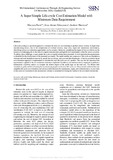JavaScript is disabled for your browser. Some features of this site may not work without it.
| dc.contributor.author | Farsi, Maryam | |
| dc.contributor.author | Erkoyuncu, John Ahmet | |
| dc.contributor.author | Harrison, Andrew | |
| dc.date.accessioned | 2022-01-20T14:59:50Z | |
| dc.date.available | 2022-01-20T14:59:50Z | |
| dc.date.issued | 2020-10-26 | |
| dc.identifier.citation | Farsi M, Erkoyuncu JA, Harrison A. (2020) A super simple life-cycle cost estimation model with minimum data requirement. In: TESConf 2020 - 9th International Conference on Through-life Engineering Services, 3-4 November 2020, Virtual Event: Host: Cranfield University | en_UK |
| dc.identifier.uri | https://doi.org/10.2139/ssrn.3718042 | |
| dc.identifier.uri | https://dspace.lib.cranfield.ac.uk/handle/1826/17456 | |
| dc.description.abstract | Life-cycle costing is a practical approach to estimate the total cost of ownership in product-service systems. In high-value manufacturing sectors, due to the complication of overhaul invoices, shop visits, repair and maintenance interventions, identifying service cost reduction opportunities can be complex. Moreover, quantifying the impact of key cost drivers on the total cost is challenging due to the lack of complete historical data and high level of uncertainties within the service cost data. To addressthese challenges, a super simple life-cycle cost model architecture is presented. A set of minimum data requirements is identified for the development of the presented cost model. The model architecture comprises of life-cycle cost breakdown structure and work breakdown structure to specify the cost drivers, unit costs and their frequencies. A bottom-up activity-based cost estimation approach is implemented to calculate the total life-cycle cost of a product. The way that the minimum data requirement is applied to the cost estimation structure is explained. In addition, the minimum data is employed to perform a deterministic sensitivity analysis to compare the relative impact of the model input on the total cost. The Monte-Carlo simulation is performed for estimating the uncertainty propagation on the total life-cycle cost. The presented model architecture simplifies life-cycle cost estimations and service control decisions for maintenance, repair, and overhaul actions. A case study of life-cycle cost estimation in the machine tool industry is considered for testing the validity of the cost model architecture. | en_UK |
| dc.description.sponsorship | Innovate UK: 103082-263289 and Cranfield University. | en_UK |
| dc.language.iso | en | en_UK |
| dc.publisher | Elsevier | en_UK |
| dc.rights | Attribution-NonCommercial-NoDerivatives 4.0 International | * |
| dc.rights.uri | http://creativecommons.org/licenses/by-nc-nd/4.0/ | * |
| dc.subject | Life-cycle Costing | en_UK |
| dc.subject | Maintenance | en_UK |
| dc.subject | Repair and Overhaul | en_UK |
| dc.subject | Activity-based Cost Estimation | en_UK |
| dc.subject | Uncertainty Analysis | en_UK |
| dc.subject | Sensitivity Analysis | en_UK |
| dc.subject | Monte Carlo | en_UK |
| dc.title | A super simple life-cycle cost estimation model with minimum data requirement | en_UK |
| dc.type | Conference paper | en_UK |
Files in this item
The following license files are associated with this item:
This item appears in the following Collection(s)
-
Staff publications (SATM) [4395]

